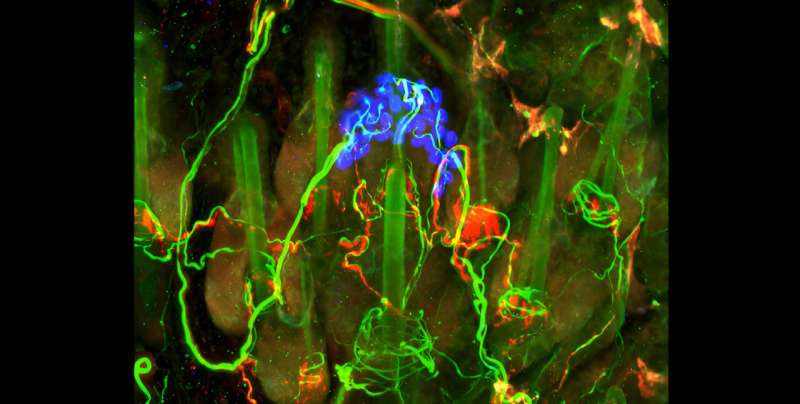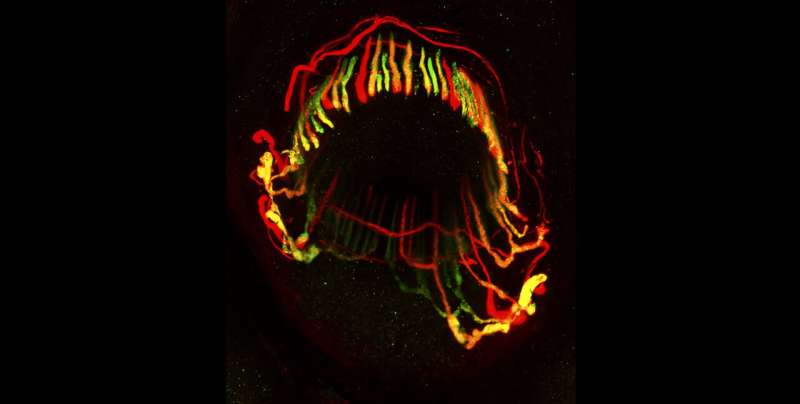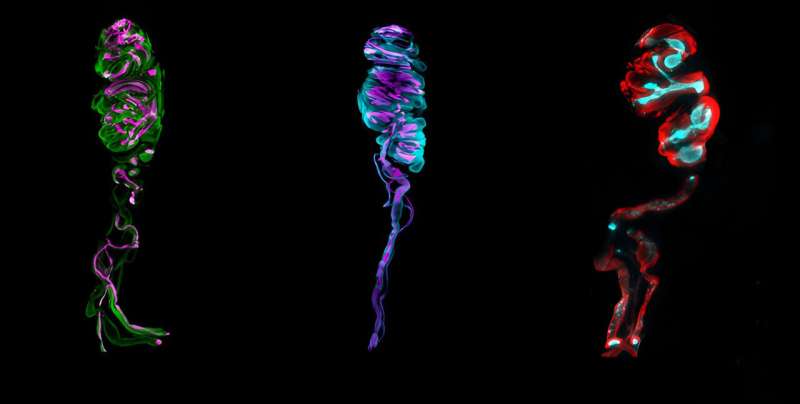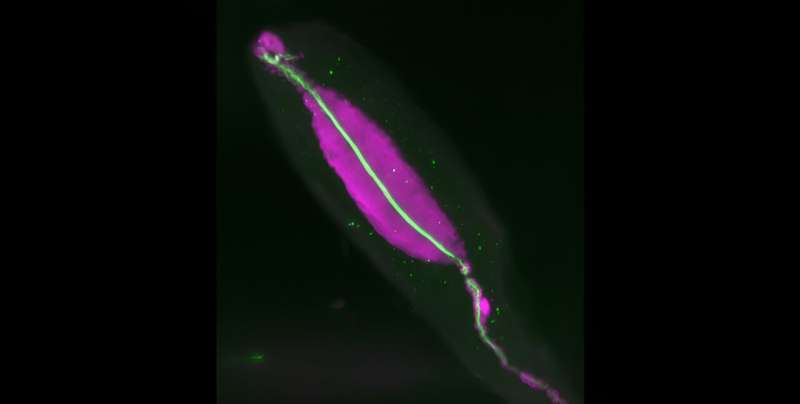This article has been reviewed according to Science X's editorial process and policies. Editors have highlighted the following attributes while ensuring the content's credibility:
fact-checked
peer-reviewed publication
trusted source
proofread
Exploring our sense of touch from every angle

Even before we are born and begin experiencing the sensations of daily life—a soft shirt on our arms, for example, or a hard tabletop under our fingertips—humans begin to form the senses needed to survive.
One of our most important senses is touch, which is the first to develop—starting only eight weeks into pregnancy—and allows us to detect and process tactile information from inside and outside the body. Touch is so integral to our lives that it's hard to imagine existing without it, in part because when touch works as it should, it fades into the background, providing a steady stream of crucial information without requiring our constant attention.
"Most people don't think about touch very much until there's something wrong with it," said April Levin, a Harvard Medical School assistant professor of neurology at Boston Children's Hospital. "It's something we take for granted because we can't shut it off, so we don't know what it's like to not have it."
Research on touch has lagged behind work on other sensory systems such as vision and hearing. Yet thanks to new research tools and greater scientific appreciation, "I think we are now in a touch renaissance," said Lauren Orefice, an assistant professor of genetics in the Blavatnik Institute at HMS. "It is an incredible time to be a sensory neuroscientist studying touch."
HMS researchers have been leading the way, simultaneously studying the basic biology of touch, and figuring out how to use this information to help people who experience abnormal touch.
The researchers are intrigued by the biological mystery of touch on a molecular and cellular level, but they also recognize the significance of their findings for illuminating brain development and developing treatments for touch dysfunction.
"Touch is fundamental to who we are and everything we do, but there's a tremendous amount that we don't know about it and need to understand," said David Ginty, the Edward R. and Anne G. Lefler Professor of Neurobiology at HMS.
What is touch?
Most of us intuitively understand touch as the way we experience the world with our skin, but the scientific definition is both more specific and more expansive. Touch is the process by which specialized neurons sense tactile information from the skin and other organs and convey this information to the brain, where it is perceived as sensations such as pressure, temperature, vibration, and pain.
"We have an incredible symphony of sensory neurons that are very diverse and heterogeneous and can pick up different qualities of touch," Orefice said.
Often, the ends of these neurons are housed in sensory structures as specialized and diverse as the neurons themselves—and so visually striking that Ginty uses photos of them to decorate his office.
Somatosensation refers to the system of sensory neurons in the skin that allows us to organize and navigate our surroundings. These neurons are remarkably precise, helping us distinguish silk from cotton, feel a cold glass or a hot mug, or detect a light breeze.
Importantly, they filter out irrelevant cues, so we're not constantly aware of background sensations like clothing on our skin. Internal sensation, or viscerosensation, encompasses the system of sensory neurons that conveys information from internal organs such as the colon to the brain.

"Touch is much more than just conscious perception of what you are actively reaching out to feel, or what is touching your skin," Ginty said. "There's a tremendous amount of operation that goes on behind the scenes."
HMS researchers are studying both somatosensation and viscerosensation, which have similarities and differences in how they work. Both systems are essential for survival, and both can become problematic. For example, people with autism may be overly sensitive to certain types of touch on their skin, and they may experience pain or discomfort in their gastrointestinal tract during digestion—an exaggerated visceral sensation.
"The body-brain relationship is really profound, and by understanding communication between the body and brain, we can begin to improve quality of life for people with all kinds of conditions, including autism," Ginty said.
Understanding touch is also critical for understanding how the brain develops, and how animals, including humans, produce complex behaviors such as social interactions.
"We often think about development from a brain-centric perspective, but our brains develop as we experience the internal and external world, and a huge part of that is sense of touch," Orefice said.
"There's an emerging, more holistic view of the brain as not developing in isolation, but actually being greatly influenced by sensation and early sensory experiences," Ginty added.
Ginty and Orefice point to research showing that children who spent their first two years in Romanian orphanages, where they experienced a lack of nurturing touch, scored lower on IQ and language tests than children with a typical upbringing. They also had higher rates of autism and psychiatric conditions such as anxiety and attention deficit/hyperactivity disorder (ADHD).
"A major question is how sensory experiences related to touch shape brain development," Orefice said. "We know that the brain changes, but we don't have a mechanistic understanding of how it changes."
Battle of the senses
Historically, and perhaps unsurprisingly, research on vision and hearing has outpaced research on touch. The visual and auditory systems are housed in discrete, localized sensory structures—the retina and the cochlea—that are easier to study. Plus, each system detects only one kind of sensory information: electromagnetic waves for the eyes, and sound waves for the ears.
Touch is, in Ginty's estimate, orders of magnitude more complex. It is enabled by a diffuse network of sensory neurons located in skin and internal organs throughout the body. Thus, touch signals must travel farther to reach the brain. Touch is also multidimensional, with information coming in myriad forms: pressure, temperature, vibration, pain, texture, tickle, itch, stretch, or chemical sensations.
"People can live without vision or hearing, but there's no way to survive without touch," Ginty said. "It's the sense that allows us to interact with the world directly, and it governs all aspects of our lives."
For example, in rare cases, people are born with an inability to feel pain or extreme temperatures—a genetic disorder called congenital insensitivity to pain. Without essential touch feedback from pain, they are perpetually vulnerable to injury and often have shortened lifespans.

In the 19th century, anatomists first studied touch by using microscopes to peer beneath the skin at what they (correctly) speculated were sensory structures containing touch neurons. In the early 20th century, scientists learned how to place an electrode on a single nerve fiber and amplify and visualize electrical impulses produced in response to sensations like indentation, temperature, and vibration.
What ensued was what Ginty described as "a 40- or 50-year period where people were randomly recording from nerves and cataloging the responses." The work, while a bit disorganized and somewhat crude by today's standards, revealed the wide range of nerve cells in the body that respond to different types of touch stimuli, and resulted in a Nobel Prize in 1944.
Another breakthrough came around the turn of the 21st century, with the advancement of molecular genetic techniques that allowed scientists to more precisely label and manipulate neurons. In 2021, researchers won a Nobel Prize for a pair of discoveries made with these techniques. The first was that the protein TRPV1 is activated by hot or cold temperatures perceived as painful by the brain.
The second was that Piezo2, a protein in sensory neurons, senses forces on the skin, and converts them into electrical signals.
Ginty's lab has been at the forefront of the field, using these approaches to study the basic biology of touch in exquisite detail. The lab uses genetic tools in mouse models to identify, isolate, and study sensory neurons in different parts of the body that communicate different types of touch to the brain.
Using this approach—described in a 2024 Cell paper—Ginty and his lab have studied neural pathways that convey light touch and vibrations and relay painful and pleasant sensations from the skin. Research fellow Rachel Wolfson and others in the lab have investigated colon neurons that detect different internal sensations and explored the role of the spinal cord and brainstem in receiving, processing, and transmitting touch signals.
"Genetically speaking, there are at least 18 distinct types of sensory neurons that care about different touch stimuli, but there could actually be more than 50. We don't even know how many there are," Ginty said.
In a 2023 study in Neuron, research fellow Annie Handler and Ph.D. student Qiyu Zhang of the Ginty lab and colleagues at the Howard Hughes Medical Institute combined genetic information about touch neurons with electron microscopy data to create highly magnified 3D images of sensory structures in the skin that detect light touch.
Through this work, the researchers developed a model for how forces on the skin interact with sensory structures to activate touch pathways to the brain.
Ginty finds the basic biology of touch fascinating in its own right, but his curiosity may lead to important therapeutic outcomes. Learning how to control touch pathways could inform the design of treatments for pain and other kinds of touch dysfunction.
"We can now study the activity of these neurons, and how they send their signals to the brain," Ginty said. "It feels like the sky's the limit not only for understanding how these systems work, but for functionally manipulating them."
When touch is too much
Orefice became interested in the basic biology of touch dysfunction, and specifically the aberrant touch experiences of people with autism spectrum disorder, as a postdoctoral fellow in the Ginty lab.

"Although it's been known for decades that sensory issues are a hallmark of autism, these issues hadn't really been studied," Orefice said.
In 2013, sensory abnormalities became a diagnostic criterion for autism. Around the same time, Orefice, Ginty, and colleagues started studying hypersensitivity to light touch—the most common touch dysfunction in autism.
The researchers developed mouse models of autism and used them to pinpoint sensory neurons that, when disrupted, give rise to touch hypersensitivity. They found that certain mutations in peripheral sensory neurons that innervate the skin caused hypersensitivity to light touch.
"Autism is canonically thought of as a brain-based condition, so the idea that peripheral neurons could contribute to any feature of autism was rather surprising," Orefice said.
Even more surprising was that introducing these mutations early in development led to anxiety-like behaviors and social changes in the mice, suggesting that normal touch sensitivity and processing are essential for normal brain wiring during development.
Orefice's lab is building on this work by studying how perturbing peripheral neurons to alter sensory experiences changes brain development. Orefice is also investigating other types of touch dysfunction in autism, including gastrointestinal abnormalities linked to chronic pain and discomfort, and oral sensitivities to food textures that can cause feeding difficulties.
"We want to understand how these systems develop and function and how they are different for individuals with autism, so we can address sensory sensitivities to improve quality of life," Orefice said. For example, she sees potential in developing therapies that directly target peripheral neurons implicated in hypersensitivity to light touch.
From mice to children
At Boston Children's, Levin is pursuing her own research on touch and neurodevelopmental conditions such as autism, working not with mice but with what she describes as "squirming 3- and 4-year-old kids."
Levin considers clinical touch tests to be generally useful but rather rudimentary and far from foolproof: For example, pressing a tuning fork to a patient's skin to assess how long they feel vibration, using the wood and cotton ends of a broken cotton swab to see if they can distinguish sharp and soft touch, or asking a patient to rate their pain on a scale from zero to 10.
"It has always struck me as a little surprising that in 2024, the best way we have to find out about someone's touch experience is to ask them," Levin said. "To some extent that's a great way to find out, and to some extent it feels low-tech, like we could do better."
Such tests can be particularly challenging for children with autism who lack the cognitive, verbal, or developmental skills to describe their sensory experiences, leaving clinicians guessing.
"I've seen kids get treated for irritability or behavior problems when they actually have a horrible toothache or constipation," Levin said. "They're acting out because that's their way of saying they're in pain, and we miss it."

Levin's lab is working on identifying biologic markers, or biomarkers of touch that would provide a more objective way of measuring sensory experiences. She noted that while many children with autism experience touch hypersensitivity, others experience touch hyposensitivity—reduced response to various sensations—or a mix of the two, further complicating the situation.
"We need biomarkers that reflect not only if you felt that, but how strongly you felt that," she said.
To this end, Levin, who collaborates with Orefice and Ginty, is developing a test to study how the brains of children with autism respond to different kinds of touch. The test combines a machine the Ginty lab uses to deliver different intensity taps to mice with electroencephalography, which involves placing electrodes on the scalp to record the brain's electrical activity.
"We have just recently started to see signals that seem to be markers of how strongly the brain is interpreting a touch signal to be," Levin said.
Such a biomarker would be an important step toward developing better therapies to treat touch dysfunction. Currently, touch hypersensitivity and hyposensitivity are largely managed through occupational therapy, because there are no medications—something Levin finds frustrating, given how consistently her patients report that their touch experiences impact their quality of life.
"Altered touch processing has downstream effects on lots of other diagnoses, such as anxiety and ADHD," Levin said. "These are biologically based challenges, so while occupational therapy can be quite helpful for some patients, we also need options for biologically oriented treatments, including medications."
Outstanding questions
Amid this touch renaissance, researchers are turning their attention to even more sophisticated questions.
Ginty wants to understand the organizational logic of touch circuits, starting with touch neurons on the body's surface, and moving step-by-step to higher order brain regions that receive touch signals. Such understanding, he said, will reveal how touch circuits underlying different sensations connect to one another and to other circuits in the body to drive voluntary and involuntary muscle movements.
Orefice is interested in how external and internal factors such as social isolation or the microbiome shape development of somatosensory and viscerosensory circuits. She also wants to investigate how the signals produced by these two types of circuits converge in the brain, and how the brain differentiates touch information coming from skin and internal organs.
Levin is eager for more research on how touch signals get turned up or down as they are converted from mechanical forces into electrical impulses, including the interplay between excitatory neurons that amplify signals and inhibitory neurons that suppress them.
Each of the three scientists is tackling touch from a slightly different angle, but they agree that touch is an endlessly fascinating field of study—one that will undoubtedly yield discoveries for decades to come.





















